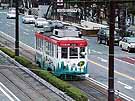
Series 3100 car, ex-Nagoya tramcar, on a modernized street in the city center area. The tram uses almost segregated track under center-pole catenary.

Series 3100 car, ex-Nagoya tramcar, on a modernized street in the city center area. The tram uses almost segregated track under center-pole catenary.
|
By Hiroshi Naito
When you travel westwards from Tokyo down the Tokaido Shinkansen, after
one and a half hours ride, you will pass a station on the ground level
adjoining a fairly complex yard of the conventional lines. The area is
Toyohashi station on the Tokaido Main Line. If you use the Kodama type
service from Tokyo, Toyohashi is the 9th stop after about a two hours
and 10 minutes ride. Toyohashi is a medium sized city located in the
easternmost part of Aichi prefecture (prefectural capital is Nagoya),
and situated as the commercial and industrial center of the region,
known as 'Mikawa'. The city is special for railway enthusiasts because
of a tramway operated by a private railway, Toyohashi Tetsudo
(Toyohashi Railway Co.). Although its system is very simple with only
5.4 km operating route length, fairly old, charming tramcars are
vividly running along modern city streets. Many of the tramcars in
service are around 50 years old, but they are reminders of the typical
Japanese tramcar style in a variety of liveries. They are former Nagoya
and Meitetsu Gifu cars along with four cars which came from Tokyo
Municipal Tramway (Arakawa Line). The tramway runs on 1,067 mm gauge
under 600V DC electrification .
The origin of the Toyohashi tramway is the Toyohashi Electric
Tramway founded in 1924. Experiencing shrinking service segments and
surviving through the adversity of anti-tramway sentiments in the 60s
through 70s, the current service between Toyohashi Station to
Akawaiwa-guchi was firmed up by 1976. Remarkably, in 1982, a 0.6 km
branch to Undokoenmae (Athletic Park) was newly constructed from a
point about 0.7 km before Akaiwa-guchi to provide easy access to the
park. Further, in 1998, the line end at Toyohashi Station was
reextended 150 meters up to the new terminus beneath the pedestrian
deck stretching in front of JR Toyohashi station, improving convenience
for passengers coming down from/to the JR station. With the city
government's positive attitude towards tram service and thanks to
enthusiastic support by the Toyohashi citizens, Toyohashi tramway is
evolving in a favorable circumstance.
If you wait for a tramcar at Toyohashi Station, it will come every
seven minutes (off peak). The destination varies between Akaiwa-guchi
and Undokoenmae (Athletic Park), but anyway, take a ride as far as
Ihara, the junction one stop before the service end. The fare is
reasonable 150 Yen. For approximately the first 2 km, the tram runs in
the modern downtown area along the center of wide streets under
center-pole catenary, in rather favorable conditions for a tramway
route in Japan. The road traffic is not very bad, and trams can make an
easy progressions on an almost segregated path along the center of the
streets. After running about 1 km in the city center area, at the
intersection between national road #1 and #259, the tramway takes the
third turn to the right. The remaining route is almost straight towards
Akaiwaguchi via Ihara. The next 1 km segment is still along a modern
tramway with the center-pole catenary up to Higashi-Haccho. Then, the
street narrows and both sides of the road change to the ambience of a
typical Japanese town with a row of wooden houses. The tram rumbles
down the street on a stone paved track, which must be a dear feature
for tram enthusiasts. Passing four stops, the tram reaches Keirinjomae
(Bicycle Race Track), where the tram's operation office is located.
There are two short sidings beside the office reached by a sharp curve
from the street, where two tramcars usually take a rest before the
evening peak. After the Keirinjomae stop, the tramway changes to single
track and proceeds along a rather narrow street up to the line end.
Ihara, about 0.5 km after Keirinjomae, is the junction where the branch
diverges to Undokoenmae. Tramcars going onto the branch take a sharp
turn with a 11 m radius, known as the sharpest curve among rail tracks
in Japan. The single track tramways continue for further a 600 m to 700
m in each direction up to both ends. Akaiwaguchi, the end of the main
line, is associated with a depot, where the tram fleet is maintained.
It is about twenty minutes ride from Toyohashi Station.
Although the Toyohashi tramway system is very simple, it is
worthwhile visiting, as one is able to enjoy tramcars of yesteryear
still in service. Toyohashi Railway also operates another rail service,
known as the Toyohashi Tetsudo Atsumi Line, which runs from JR
Toyohashi station south eastwads up to Mikawa-Tahara on Atsumi
Peninsula. This about 18 kms long EMU service is a heavy single track
railway electrified at 1500 volts. After coversion from 600 volts, the
line's fleet consisted of about 40 years old stock, 7300 series which
came from Meitetsu (Nagoya Railway), but is now in the process of
replacement with modern stock of ex-Tokyu 7200 series withdrawn from
the Tokyu Mekama (now Tamagawa) and Ikegami Lines due to the opening the Meguro Line in October 2000. Toyohashi is also the south end of Meitesu main line,
which comes into JR Toyohashi station sharing the JR Iida Line track
(the JR Iida Line also originates from Toyohashi). At JR Toyohashi
station, you will see a variety of rolling stock from the JR Tokaido
main line, Iida Line and Meitetsu main line. With the Toyohashi Tetsudo
tramway and Atsumi Line along providing a spectacle in Toyohashi
station, Toyohashi must be worth stopping by for a while on your
Tokaido Shinkansen trip.
All the photos in this page were taken by the author in November 2000.